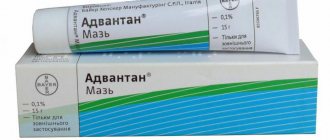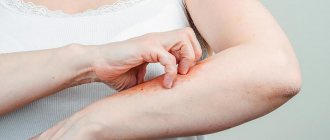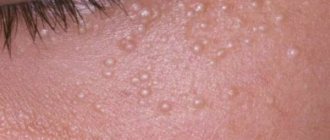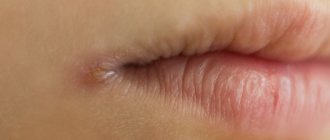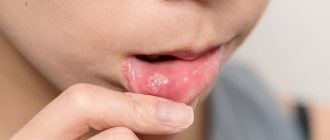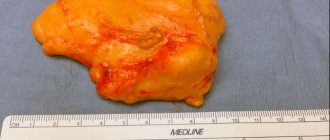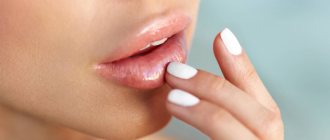Dermatological pathologies, as a rule, do not pose a threat to health, but they cause serious discomfort to their owner and often even cause a decrease in performance. What should you do if blisters appear on your body, they itch like insect bites, and cause pain and discomfort? Of course, you should visit a dermatologist and get qualified advice. However, you can often independently determine the reason why the blisters, similar to bites, itch and hurt. The article presents a list of the main pathologies that cause such symptoms and treatment methods.
Classification and manifestation of fluid blisters
Blisters on the skin that contain fluid inside are classified according to the following classification:
- Symptomatic;
- Allergic blisters;
- Mechanical effect on the skin.
Symptomatic blisters
This type of formation is one of the main symptoms of an infectious disease.
Formations appear as follows:
- Small blisters form;
- The formation contains a clear liquid;
- The thin film on the formation is quickly damaged and turns into a wound;
- It can form in almost any part of the body.
Allergy blisters
They are a symptom of skin surface contact with an allergen. Very often, allergic rashes appear after using low-quality cosmetics or contact with plants.
Formations appear as follows:
- Redness appears on the skin, which turns into a large number of small blisters with liquid;
- The formations create a large number of unpleasant sensations for a person, including a feeling of itching;
- They tend to disappear quickly after using antihistamines;
- Most often they appear on the arms, shoulders and legs.
As a result of mechanical action on the skin
The appearance of such blisters is promoted by contact with hot objects and direct sunlight, as well as damage to the epidermis.
Such formations have the following properties:
- Large blisters;
- Occurs directly at points of contact;
- Can persist for a long time;
- Upon palpation, a person feels pain;
- After the bubble is damaged, a wound is formed in its place;
- Most often they occur on the arms, legs, and shoulders.
When this kind of blisters appears on the body, it is forbidden to comb them and damage their integrity, otherwise infection may occur and the disease may worsen.
Atopic dermatitis: symptoms and treatment methods
The causes of atopic dermatitis are still unknown for sure. It can appear in both infants and adults. As a rule, at first the skin simply turns red. Over time, itching, burning, and small blisters begin to appear. “Favorite” places for atopic dermatitis: cheeks, lower back, shoulder blades, calves, forearms.
There is only one non-drug way to get rid of the manifestations of atopic dermatitis: a strict diet. As a rule, through selection, those products are determined, against the background of which dermatitis becomes less and eventually disappears completely.
There are also medicinal methods of treatment: for example, Advantan cream is highly active due to the content of corticosteroids in its composition. Already on the second or third day of treatment, the patient feels significant relief. The disadvantage of this remedy is that, as a rule, after stopping the drug, all the symptoms return again. The main key to the success of treatment is to eradicate the cause that caused the blisters to appear. Itchy legs, like insect bites, but there are no other symptoms - it is likely that the cause of this condition is atopic dermatitis.
Causes
The appearance of blisters on the skin can occur for various reasons. Each type of disease has its own characteristics and requires special diagnostics.
Infectious diseases
Damage to the body by infectious diseases contributes to malfunctions of internal organs, which often appear on the skin in the form of various types of blisters with fluid inside.
Infectious diseases include:
Chicken pox
Chickenpox is characterized by the appearance of spots on the skin, which gradually turn into small blisters containing a cloudy liquid inside.
Locations:
- Face;
- Hands;
- Stomach;
- Mucous membranes;
- Breast;
- Buttocks.
The formations are accompanied by symptoms of severe itching and increased body temperature.
Streptoderma
The causes of skin damage are streptococcal infections, which destroy skin cells and cause rashes.
This type of skin infection most often occurs in childhood and most often occurs in the following places:
- Face;
- Hands;
- Mucous membranes;
- Breast.
The most common causes are contact with an infected person and failure to maintain necessary body hygiene.
Blisters have the following features:
- A spot forms on the skin, which turns into small blisters containing a cloudy liquid;
- After a few days, the blisters crust over;
- The formations cause a burning sensation and are often accompanied by general weakness and fever.
This type of disease can last a long time, decreasing and increasing its activity in the body.
Scabies
An infectious disease that occurs as a result of damage to skin cells by mites. The disease is classified as contagious and is accompanied by a large number of unpleasant symptoms.
Locations:
- Between the fingers;
- On the palms;
- On the wrists;
- Buttocks;
- Elbow bends.
Features of blisters:
- Small formations;
- Accompanied by swelling of the skin and severe itching;
- Blisters may contain pus;
- When scratching the formations, the infection is transmitted to healthy areas of the body.
This type of infection requires long-term treatment and regular use of antibacterial drugs.
Herpes zoster
An infectious skin lesion that is transmitted through contact with an infected person, or through the use of shared household items.
The localization sites for this type of disease are the ribs and abdomen; if the papules are damaged, the infection can be transferred to healthy areas of the body.
Peculiarities:
- Accumulation of papules in large numbers;
- Papules contain liquid with impurities of pus, after damage, which form a crust;
- At the sites of formations, the skin swells and becomes inflamed, and a red spot appears.
When the first signs of lichen occur, it is necessary to undergo appropriate diagnostics and undergo a course of treatment to eliminate the infection.
Viral diseases
Some viral diseases tend to appear on the skin in the form of blisters.
Such diseases include:
- Molluscum contagiosum;
- Herpes;
- Parvovirus B19.
Molluscum contagiosum
The disease, which occurs as a result of a viral infection of the skin, is manifested by the appearance of a specific rash.
Locations:
- Face;
- Torso;
- Groin.
Peculiarities:
- Small flesh-colored formations;
- Most often occurs in children under 14 years of age;
- The skin rash has a shiny surface.
In adults, this type of disease most often occurs on the genitals.
Herpes
Formed as a result of the introduction of a virus into the body, it manifests itself as a specific rash with liquid inside.
Locations:
It appears as a small rash, which is most often pink in color and may contain purulent fluid. The disease is contagious and tends to infect healthy areas of the body when scratched.
Parvovirus B19
A viral infection of the body that occurs most often in childhood. It is transmitted by airborne droplets and tends to cause epidemics, especially in the spring season.
Locations:
- Cheeks;
- Wrists;
- Stomach.
Features of manifestation:
- Bright red spots form on the skin;
- A few days after infection, lace-shaped blisters appear that contain a gray fluid and are accompanied by itching.
This disease most often lasts at least 10-14 days and requires complex treatment.
Diseases related to the endocrine system
The endocrine system is responsible for the normal functioning of many internal organs; in the event of any disease, disruptions in the body and the appearance of a large number of unpleasant symptoms may occur.
The following types of diseases can contribute to the appearance of a specific rash in the form of papules on the skin:
- Thyroid;
- Pancreas;
- Adrenal gland;
- Sex glands in women.
Locations of blisters on the body:
- Face area;
- Breast;
- Shoulders.
Features of blisters:
- The rash contains a clear liquid and can form as one of the first symptoms of the disease;
- Most often it does not cause itching or burning;
- Of red color;
- It may go away on its own in a few days.
Only diagnosis can correctly determine the type of disease; disruption of the endocrine system very often leads to general weakness and increased body temperature.
Autoimmune diseases
This group of diseases includes a large number of diseases that manifest themselves in different ways.
The formation of this type of lesion occurs as a result of an increased number of lymphocytes, which the human immune system cannot cope with.
Pemphigus
Pemphigus appears when the infection is transmitted by airborne droplets. With reduced immunity, a person begins to produce antibodies, which appear on the skin in the form of blisters.
Locations:
- Mucous membranes;
- Stomach;
- Face;
- Legs;
- Breast.
Features of formations:
- Bubbles appear in large sizes and contain yellow liquid;
- When the integrity of the surface is damaged, ulcers with a white coating appear on the body;
- Wounds are accompanied by pain and inflammation of the skin.
The disease very often has complications, which are manifested by additional infection of the formations, resulting in the appearance of crusts and the release of pus.
Autoimmune urticaria
It manifests itself as a result of decreased immunity, which is unable to cope with external irritants.
Locations of the rash:
- Hands;
- Neck;
- Legs.
A red blister forms with a cloudy liquid inside.
Diseases associated with oncology
Oncological diseases are one of the most complex and dangerous types of damage to the human body.
There are no identical symptoms of the development of the disease; each patient with cancer can observe his own unique symptoms of the disease.
Many people experience the appearance of flesh-colored papules on the skin, which are most often localized in places:
- Breasts;
- Belly;
- Faces;
- Hair growth area;
- Mucous membranes.
The area of location depends on the type of disease; most often such formations are located in pairs and have clear boundaries with a red rim. The blisters are dense to the touch, contain clear liquid, and when damaged, form a thin crust.
Allergic reactions
An allergic reaction occurs as a result of the influence of an allergen on the human body; most often, the first symptoms of the disease appear on the skin in the form of rashes.
Allergic manifestations in the form of blisters can form from the following types of reactions:
Features of manifestation:
- The blisters contain clear fluid;
- Have increased symptoms of itching and burning;
- Promotes swelling of the skin;
- After a certain time, they can transform into pimples and become covered with a dense crust.
Locations:
- Buttocks;
- Face;
- Back;
- Breast;
- Hands.
Such a rash may appear until all allergens are completely eliminated.
Dermatitis herpetiformis
Dühring's disease manifests itself as a result of the body's reaction to food components, most often protein and gluten.
Locations:
- Elbow bends;
- Shoulder blades;
- The area of the inner side of the knees;
- Buttocks;
- Small of the back.
Peculiarities:
- The blisters contain yellow contents;
- Blisters quickly become damaged and form erosions;
- Papules size up to 3 mm;
- A dense arrangement of blisters is observed.
Most often, this type of disease affects men under 40 years of age.
Fungal infections
Skin lesions that are formed as a result of skin damage by pathogenic fungi, penetrating into the upper layers of the epidermis and destroying skin cells.
Locations:
- Between fingers and toes;
- Hands;
- Nails;
- Mucous membranes.
Peculiarities:
- Redness appears on the skin, accompanied by itching;
- Small, flesh-colored pimples appear;
- When scratching, fungal infections can be transmitted to healthy areas of the body.
The disease can have various stages of progression, form a crust that secretes a specific purulent fluid.[/wpmfc_cab_si
Neurodermatitis
Skin lesions with neurodermatitis occur as a result of a viral infection or the presence of constant stressful situations.
Most often, this type of dermatitis occurs in children under 8 years of age and is manifested by itching and burning of the skin, as well as the formation of a specific rash in the form of blisters.
Locations:
- Face;
- Elbow and knee bends;
- Hands;
- Neck;
- Buttocks;
- Folds of skin.
Features of the rash:
- Small red blisters form;
- Purulent formations may be observed;
- Blisters have a thin surface and quickly rupture, forming an ulcer;
- Ulcerative lesions can merge and form one continuous wound.
[wpmfc_cab_si]This type of skin lesion can manifest itself in waves, gradually increasing and decreasing its symptoms.
Rheumatoid arthritis
This type of disease occurs as a result of damage to the joints of the arms and legs.
Most often it appears over the age of 35 and can be accompanied by a large number of unpleasant symptoms.
They appear most often on the arms and legs, but depending on individual characteristics, they can appear in any part of the body.
At later stages of the development of the disease, a person may observe the presence of papules throughout the body, which are accompanied by itching and burning and contain gray contents.
Calluses
The formation of calluses is primarily associated with the mechanical impact of objects on the skin.
This could be shoes, things or long-term physical work.
Most often they form on the arms and legs; they can be soft and dense depending on the method of formation.
Most often they contain a clear liquid and after damage they form wounds that can heal for a long time and cause pain to the person.
Thermal burns
They are formed from contact of the skin with fire or hot objects, on almost any part of the body.
Peculiarities:
- Large blisters form;
- The person feels symptoms of pain and burning;
- After damage, a wound remains at the burn site.
It is forbidden to puncture or damage such blisters; infection may occur and pus may form.
Chemical burns
Chemical substances tend to penetrate deeply into the layers of the epidermis and destroy it; such burns form blisters, which have serous contents, often mixed with blood.
They can form anywhere, but most often it is in the arm area.
Bubbles Features:
- Most often have a medium size;
- Unlike a regular burn, they are formed from several formations;
- After damage, a deep ulcer forms;
- The wounds do not go away for a long time, and destruction of healthy skin edges may occur.
Getting burns from chemicals is very dangerous and requires urgent medical attention.
Burn from direct sunlight
Sunburn occurs as a result of damage to the upper layer of the epidermis, forming blisters with clear liquid.
Locations:
- Shoulders;
- Nose;
- Hands;
- Legs;
- Breast.
Peculiarities:
- As a result of sunburn, the skin becomes covered with red spots;
- A few hours after the burn, large and small blisters become noticeable on the skin;
- The blister persists for several days, after which it begins to burst;
- A person feels a feeling of itching in the areas where the blister is damaged.
Such blisters often leave behind scars and age spots.
Insect bites
When an insect bites, poison gets into the layers of the epidermis, to which a person can develop an allergic reaction.
Very often, bite allergies manifest as blisters that form around the bites.
These blisters go away on their own within a short time.
Hives
Urticaria (Uriticaria)
Sometimes also called nettle rash, urticaria is a dermatological condition characterized by pale red or white, raised, itchy rashes (blisters), each surrounded by a small red spot on the skin. The condition of the skin is very similar to a nettle burn.
According to Dermnetz.org, these blisters can be large, ranging in size from a few millimeters to several centimeters, making them look like swelling on the skin.
Hives are often associated with allergies, although there are many non-allergic causes. Allergic reactions promote the release of histamine and basophils, which then lead to damage to small blood vessels.
The rash may appear within minutes and go away within a few hours, and usually tends to change over time. The shape of the blisters varies from round and ring-shaped to uneven, reminiscent of a geographical map.
Although in most cases symptoms disappear in less than 24 hours, new blisters may appear as old ones clear up, sometimes migrating throughout the body.
Treatment
Hives are not a serious condition in most cases, and treatment is usually not required.
However, you can soothe the itching by taking an oral antihistamine, such as Zyrtec or Benadryl, or by applying calamine lotion. A cool bath may also help.
It is recommended to avoid exposure to any environmental elements or foods that may be a potential trigger for allergic reactions.
If this condition persists, you should consult your doctor. Steroid creams may need to be prescribed for a short period of time to reduce swelling. Antileukotriene therapy may also be prescribed to control histamine release.
Causes of blistering in newborns
In infants, formations with fluid may appear for the following reasons:
- Herpes – watery pimples appear in the mouth, nose and genitals. After a few days, the blister becomes purulent and can spread to healthy areas of the skin;
- Streptoderma is the formation of large purulent blisters on the skin, most often appearing in the face area, after which it spreads throughout the body;
- Enterovirus is a viral infection of the body in which blisters with liquid appear, which tend to form in almost any part of the body;
- Pemphigus is the appearance of a watery rash with a rim around the formation. Most often occurs in the oral cavity on the abdomen and arms;
- Allergic rash - most often occurs on food, appears on the face in the form of papules with purulent content;
- Miliaria is a fairly common phenomenon in newborn children, especially in the summer, in the heat, since their skin is very sensitive to temperature changes and any other irritants.
Very often, blisters appear on the skin of newborns as a result of poor-quality clothing that causes irritation.
Therapy
The course of medications is prescribed only by a doctor. Self-medication when a rash occurs is unacceptable; it often becomes a threat to the patient and the people around him. Treatment for itchy blisters is aimed at eliminating the underlying cause, after which the rash begins to disappear.
It is forbidden to scratch the rash or intentionally open its elements; this sometimes leads to infection of the wounds. The bubbles should burst spontaneously.
Traditional medicine
If the rash is caused by viruses (herpes, chickenpox), antiviral drugs are used:
Antihistamines are prescribed to relieve itching:
Blisters are treated with antiseptics:
- brilliant green;
- Fukortsin;
- potassium permanganate solution.
Herpes on the lips can be treated with ointments:
To relieve fever, pain and inflammation use:
To treat contact dermatitis, use:
- antiallergenic agents (Claritin, Loratadine, Diazolin);
- corticosteroids (Sinaflan, Advantan, Dermovate, Lokoid);
- enterosorbents (Polysorb, activated carbon);
- immunomodulators (tincture of echinacea, ginseng, eleutherococcus);
- multivitamins (Alphabet, Vitrum).
- corticosteroids (Hydrocortisone, Lorinden);
- antihistamines (Bepanten, Elokom, Advantan).
Fungal infections are treated with:
- local medications (Mikospor, Lotseril, Lamisil, Exoderil);
- antifungal drugs taken orally (Terbizil, Griseofulvin, Flucostat);
- sorbents (Enterosgel, Polysorb MP);
- immunomodulators (tincture of echinacea, ginseng, eleutherococcus).
Streptoderma is suppressed using:
- antiseptics for treating rashes (salicylic alcohol, brilliant green, Fukortsin);
- ointments with antibiotics (Triderm, Erythromycin ointment, Baneocin).
If a bacterial infection is added to the underlying cause of the rash with watery blisters, use:
- antibiotics (Augmentin, Amoxicillin, Erythromycin);
- immunomodulators (Immunal, Immunorm, echinacea extract, ginseng, eleutherococcus).
Folk remedies
Traditional medicine is added to complex treatment. Allergic reactions are relieved with herbal decoctions:
- Yarrow. Brew 1 tablespoon of the plant in 250 ml of boiled water. Let it brew for 1 hour. Drink 1 glass 3 times a day. The course of treatment is 21 days. The product successfully fights cold allergies.
- A series. In the evening, boil 1 liter of water, pour 4 tablespoons of the plant into the liquid, and leave until the morning. Take half a glass 3 times a day. Treatment lasts 21 days. The sequence is useful for food allergies.
Fungal infections are treated using the following:
- Strong coffee. The grains are ground in a coffee grinder, brew 5 teaspoons in 500 ml of boiling water, allow to cool to 37-40 0 C. Take 15-minute baths, immersing your hands or feet in the healing solution.
- Tea tree oil. The affected areas are treated with oil 3 times a day. The product is applied with a cotton pad. The skin stops peeling and itching, the blisters dry out and heal.
Baths and lotions with oak bark help cure dyshidrosis and prickly heat:
- For 2 liters of boiling water, take 8 tablespoons of plant material. The solution is cooled to 37-40 0 C, and baths are taken. The duration of the procedure is 15-20 minutes.
- Brew 1 teaspoon of bark in 250 ml of boiling water. When the infusion has cooled to a comfortable temperature, moisten a napkin in it and apply it to the affected area. Leave the application until it dries.
With the correct diagnosis and timely treatment, itchy blisters heal quickly without causing complications.
Every person who is faced with the problem of a skin disease, like no one else, can tell you what unpleasant sensations itching and burning of the skin causes.
When this kind of discomfort occurs, you want to find out the causes of any formations on the skin as soon as possible in order to quickly eliminate them.
Most often, the body becomes blistered and itchy.
Such formation interferes with a person’s normal life activities, since the blister itches. What is the reason for their appearance and methods of treatment - we will talk about this in our article.
Causes of blisters in children
In childhood, the following factors most often contribute to the appearance of blisters:
- Chicken pox is caused by an infection that is transmitted by airborne droplets. The disease begins its symptoms in the facial area and gradually spreads to the whole body;
- Herpes zoster manifests itself as small blisters that become cloudy after three to four days. Most often it forms in the head, back, shoulders, arms;
- Burns – occur under the influence of external factors on the child’s skin and are manifested by the formation of large blisters with liquid.
In addition, common causes of watery acne are allergic reactions and malfunctions of internal organs.
Bad habits as a factor in the appearance of blisters
If a patient has been suffering from dermatological pathologies for a long time, and neither pharmacological drugs nor diet help him get rid of them, then he should think about his lifestyle. How often does the patient drink alcoholic beverages and does he smoke? These bad habits slowly but inevitably “undermine” the body’s defenses; over time, large blisters appear on the body, itching like bites - this is a symptom of dermatological pathologies. Over time, the body can become so exhausted that it is simply unable to resist even the spread of fungal spores.
If no treatment helps with the appearance of dermatitis and blisters, or only helps for a short period of time, then you should think about the need to completely stop smoking and drinking alcohol, even in small quantities. Judging by the experience and reviews of people who were able to get rid of dermatitis, this method really helps. At the same time, you should minimize or completely avoid the consumption of salt and sugar.
Causes of acne with fluid during pregnancy
Any type of rash on the body during pregnancy may indicate the presence of malfunctions in the functioning of internal organs and requires detailed diagnosis.
The most common reasons:
- Urticaria is most often formed as a result of the body’s reaction to food. Localized in the arms, abdomen, face. Accompanied by itching and looks like blisters with liquid contents;
- Miliaria - occurs most often in the last stages of pregnancy in the summer. Pimples with liquid contents form in the folds of the skin and under the abdomen; after damage to the membrane, a crust forms that itches and burns;
- Chicken pox - affects women if they have not previously had this type of disease;
- Dermatosis of pregnant women - forms in places where stretch marks form and manifests itself as blisters of a transparent color. Very often, this type of rash goes away on its own and does not require special treatment.
In addition to the main types of diseases that affect the period of bearing a child, a woman is not protected from the risk of contracting herpes or scabies, which also have symptoms such as the formation of blisters on the body.
Why does the body itch?
The reasons for itching the body in different places may be different. Among them are general and skin diseases, allergies, and insect bites. To establish the cause of persistent itching, you need to consult a doctor who will offer to donate blood and urine for general clinical tests. If an allergy is suspected, appropriate tests are used, which allows you to quickly identify the allergen and remove it from the environment or menu.
Rash on the body due to allergies
If a person is prone to allergic reactions, then upon contact with an allergen, the brain sends a signal about a large release of histamine, a hormone that causes the sensation of itching. Prolonged scratching of the skin can lead to infection and the onset of an inflammatory process. Usually the body itches in different places in turn and does not go away for a long time precisely due to an allergy to something. If such symptoms appear, you should consult a doctor who will determine the allergen. It often happens that a person has not complained about negative reactions all his life, but suddenly an allergy to the most common product appears.
In cases where the body itches in different places and spots appear, the skin becomes covered with rashes, whether it is an allergy or not can be established in a simple way.
You need to lightly press the area with the rash with your finger, and then quickly remove it, as in the photo. If the rash is of allergic origin, then the spot will remain pale for a while after you remove your finger. If the itching and rash are related to skin diseases or infections, then after removing the finger the rash will not change color, but will remain red.
Infectious diseases
Having carried out your own diagnosis using this method, still do not delay going to the doctor. Any skin rash may be a sign of infectious diseases:
Rash on the body due to rubella
- measles;
- scarlet fever;
- measles rubella;
- chickenpox and others.
In children, these infections are usually mild, but adults suffer from childhood illnesses with difficulty. The sooner the disease is identified and treated, the less consequences there will be.
In addition to skin diseases, the body itches in different places and red spots appear after insect bites. These include:
Spot after a tick bite
- mites;
- bees and wasps;
- mosquitoes;
- ground fleas and others.
- The body reacts to the poison that gets under the skin with a rush of blood, which, together with insect toxins, leads to burning and itching.
Skin diseases
If at first the body itches in different places, then changes in the skin appear in the form of spots, as in the photo, this is typical for psoriasis.
Psoriasis spots
Other diseases that affect the skin:
- lichen planus;
- seborrhea;
- dermatitis of various origins;
- mycosis (fungus);
- xeroderma (mild form of ichthyosis).
All of these diseases can be treated with medications with varying degrees of success.
First aid
If blisters form on the skin, which are symptoms of the disease, you must:
- Reduce the likelihood of damage to the integrity of formations;
- Remove contaminants from the affected area;
- If this is an allergic reaction, it is necessary to eliminate the possible allergen;
- Carefully treat the formation with alcohol;
- Do not use ointments and creams on your own;
- Contact a medical facility.
In case of burns, the following actions must be taken:
- Eliminate the factor that caused the skin damage;
- Clean the surface of the blister from contamination using boiled water at room temperature;
- Apply a cold compress to the blister;
- Treat with an antiseptic.
Calluses must be treated with an antiseptic drug and covered with a band-aid.
In what cases is it necessary to consult a doctor?
If blisters form on the skin, you should seek help from a medical facility in the following situations:
- The blisters appeared for an unknown reason as a symptom of some disease;
- The formations arose in the child;
- The contents of pimples have purulent contents;
- The rash quickly spreads throughout the body;
- The rash is accompanied by unpleasant symptoms;
- The burn is large;
- The rash is accompanied by inflammation and swelling of the skin.
All types of skin rashes require consultation with a specialist; you should not self-medicate.
Drug treatment
Each type of disease requires a special type of treatment.
Allergy
Allergic reaction - for the treatment of watery formations the following is used:
Scabies
For the treatment of scabies it is recommended:
- Preparations containing sulfur , for example Sulfur ointment;
- Synthetic antiparasitic agents – Spregal, Benzyl benzoate;
- Antiseptic skin treatment , for example Medifox.
Sulfur ointment Spregal Benzyl benzoate Medifox
Neurodermatitis
Neurodermatitis is eliminated as follows:
- Anti-allergy medications – Erius, Tavegil;
- Anti-puffiness of the skin - Boric ointment;
- Vitamins.
Erius Tavegil Boric ointment
Herpes and lichen
For the treatment of herpes and lichen, the following is most often used:
- Antiviral agents – Acyclovir;
- Anti-inflammatory drugs – Meloxicam, Naproxen;
- Local therapy - Fukortsin, Pentsivir.
Chicken pox
For chickenpox it is used:
- Antiviral drugs - Famvir tablets;
- Zelenka for local therapy.
Famvir Zelenka
Pathogenic fungi
To eliminate pathogenic fungi, the following is used:
- Local treatment to eliminate the infection - Mikoseptin, Ifenek;
- Antifungal agents – Lamisil, Flucanazole.
Mikoseptin Ifenek Lamisil Fluconazole
All treatment methods and drugs are used strictly as prescribed, after being prescribed by a specialist.
Treatment with folk remedies
The use of folk remedies can reduce unpleasant symptoms and eliminate the appearance of skin rashes:
- Peach oil – reduces the likelihood of damage to formations, eliminates itching. Apply a small amount of oil to the affected area and leave until completely absorbed. Not for use in case of individual sensitivity to the component;
- Baths with medicinal herbs help provide an antibacterial effect and eliminate itching. It is necessary to mix chamomile flowers, calendula, nettle leaves, and oak bark in equal proportions. Pour water over all ingredients and bring to a boil. Leave to infuse for 30 minutes, strain and add to a bath of water. Use this bath every day for 20 minutes. It is forbidden to dry yourself with a towel; you must carefully blot the liquid;
- Aloe juice has antibacterial and antiviral properties. Grind the aloe leaf and soak it in water for several hours. Strain the mixture, moisten a piece of gauze, apply to the damage for 20 minutes;
- Series - used to relieve inflammation. Bring a small amount of herb to a boil, cool and strain. Moisten a cotton swab and apply to the rash on the epidermis. Used during pregnancy and from the first days of life.
Before using traditional medicine measures, it is necessary to conduct a sensitivity test.
Therapy
The course of medications is prescribed only by a doctor. Self-medication when a rash occurs is unacceptable; it often becomes a threat to the patient and the people around him. Treatment for itchy blisters is aimed at eliminating the underlying cause, after which the rash begins to disappear.
It is forbidden to scratch the rash or intentionally open its elements; this sometimes leads to infection of the wounds. The bubbles should burst spontaneously.
Traditional medicine
If the rash is caused by viruses (herpes, chickenpox), antiviral drugs are used:
- Virolex;
- Acyclovir.
Antihistamines are prescribed to relieve itching:
- Claritin;
- Tavegil;
- Zyrtec;
- Suprastin.
Blisters are treated with antiseptics:
- brilliant green;
- Fukortsin;
- potassium permanganate solution.
Herpes on the lips can be treated with ointments:
- Penciclovir;
- Acyclovir.
To relieve fever, pain and inflammation use:
- Ibuprofen;
- Lidocaine gel;
- Paracetamol;
- Aspirin.
To treat contact dermatitis, use:
- antiallergenic agents (Claritin, Loratadine, Diazolin);
- corticosteroids (Sinaflan, Advantan, Dermovate, Lokoid);
- enterosorbents (Polysorb, activated carbon);
- immunomodulators (tincture of echinacea, ginseng, eleutherococcus);
- multivitamins (Alphabet, Vitrum).
Dyshidrosis is treated:
- corticosteroids (Hydrocortisone, Lorinden);
- antihistamines (Bepanten, Elokom, Advantan).
Fungal infections are treated with:
- local medications (Mikospor, Lotseril, Lamisil, Exoderil);
- antifungal drugs taken orally (Terbizil, Griseofulvin, Flucostat);
- sorbents (Enterosgel, Polysorb MP);
- immunomodulators (tincture of echinacea, ginseng, eleutherococcus).
Streptoderma is suppressed using:
- antiseptics for treating rashes (salicylic alcohol, brilliant green, Fukortsin);
- ointments with antibiotics (Triderm, Erythromycin ointment, Baneocin).
If a bacterial infection is added to the underlying cause of the rash with watery blisters, use:
- antibiotics (Augmentin, Amoxicillin, Erythromycin);
- immunomodulators (Immunal, Immunorm, echinacea extract, ginseng, eleutherococcus).
Folk remedies
Traditional medicine is added to complex treatment. Allergic reactions are relieved with herbal decoctions:
- Yarrow. Brew 1 tablespoon of the plant in 250 ml of boiled water. Let it brew for 1 hour. Drink 1 glass 3 times a day. The course of treatment is 21 days. The product successfully fights cold allergies.
- A series. In the evening, boil 1 liter of water, pour 4 tablespoons of the plant into the liquid, and leave until the morning. Take half a glass 3 times a day. Treatment lasts 21 days. The sequence is useful for food allergies.
Fungal infections are treated using the following:
- Strong coffee. The grains are ground in a coffee grinder, brew 5 teaspoons in 500 ml of boiling water, allow to cool to 37-40 C. Take 15-minute baths, immersing your hands or feet in the healing solution.
- Tea tree oil. The affected areas are treated with oil 3 times a day. The product is applied with a cotton pad. The skin stops peeling and itching, the blisters dry out and heal.
Baths and lotions with oak bark help cure dyshidrosis and prickly heat:
- For 2 liters of boiling water, take 8 tablespoons of plant material. The solution is cooled to 37-40 C, and baths are taken. The duration of the procedure is 15-20 minutes.
- Brew 1 teaspoon of bark in 250 ml of boiling water. When the infusion has cooled to a comfortable temperature, moisten a napkin in it and apply it to the affected area. Leave the application until it dries.
With the correct diagnosis and timely treatment, itchy blisters heal quickly without causing complications.
What to do if itching occurs?
If the blisters start to itch:
- Limit all possible contacts with the affected area (applies to infectious and viral diseases) healthy areas of the body can become infected;
- Apply a cold compress;
- Use an antihistamine (allergy and chicken pox);
- Treat with an antiseptic (for burns and calluses);
- Contact your doctor.
If necessary, a bandage can be applied to the area that is very itchy.
Diet and skin condition
Changing your diet almost always brings relief of symptoms, whatever the diagnosis - allergies or dermatitis (except for infectious diseases). You should exclude the following categories of foods from your diet:
- fast food;
- hot and spicy spices;
- salt and sugar - reduce to a minimum;
- carbonated, sweet and alcoholic drinks;
- confectionery;
- vegetables and fruits of bright colors.
Reviews from patients indicate that after switching to proper nutrition, the number of rashes is reduced, and overall well-being improves and performance increases.
Prevention
To reduce the risk of papules forming on the epidermis, the following prevention methods must be followed:
- Following a diet that reduces the consumption of allergenic foods;
- Do not use other people’s personal hygiene products and utensils;
- Avoid stressful situations;
- Increase the protective functions of the immune system with the help of vitamins;
- Treat all types of diseases in a timely manner;
- Avoid visiting public places during periods of exacerbation of viral infections;
- Maintain proper body hygiene;
- Reduce the risk of contact with infected people.
Following simple prevention rules will reduce the likelihood of infection and eliminate long-term treatment.
Prevention of dermatological pathologies: advice from doctors
Dermatologists recommend following these simple rules in order to avoid the appearance of dermatological pathologies:
- Wash your hands thoroughly before eating and coming from outside.
- Observe personal hygiene rules.
- Wash food before eating.
- If there are pets in the house, monitor the condition of their fur and skin and treat if necessary.
- To refuse from bad habits.
- Reduce your consumption of fast food, sweets, sugar and salt to a minimum.
